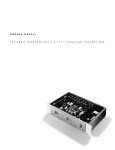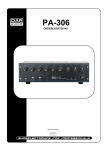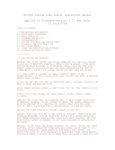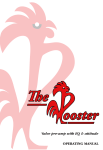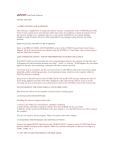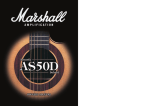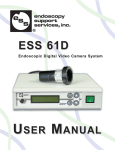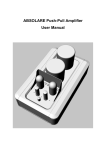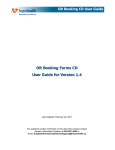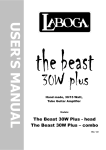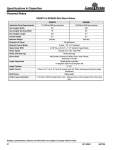Download HE HOENIX - Digiland Srl
Transcript
THERMIONIC CULTURE THE PHOENIX valve master compressor OPERATING MANUAL WARNING For your personal safety, please read this operating manual and warning thoroughly before using the equipment. This unit must be installed in such a manner that operator access to the mains plug is maintained. Where the product is to be rack mounted, this may be achieved by having access to the disconnection device for the whole rack. To reduce the risk of electric shock, it is essential that the unit is disconnected from the mains supply before removing the cover. Please also note that the power supply capacitors within this unit can remain charged even after the mains supply has been disconnected. It is essential that these capacitors are discharged after the mains supply has been disconnected and the covers have been removed. In the event that this unit has been dropped or has suffered an impact, an electrical safety test must be carried out before reconnection to the mains supply. This equipment is not intended for use in explosion hazard environments. It must be used and stored in studio conditions, such that the ambient relative humidity does not exceed 80%, nor is the temperature to be allowed to drop to a level which would cause dew point to be reached. Please ensure that adequate ventilation is provided and that the ventilation slots are not obstructed. When rack mounting this equipment, a fan may be required to provide sufficient airflow. ©Thermionic Culture Ltd, February 2007 1 CONTENTS Section Page 1 Introduction 3 2 Controls & Operation 4 2.1 Output trim 4 2.2 Gain 4 2.3 Attack 4 2.4 Release 4 2.5 Threshold 5 2.6 Bypass 5 2.7 Link 5 2.8 Pre-sets 6 2.9 Meters 6 3 4 Servicing & Maintenance 7 3.1 Valves 7 3.2 Operating voltage / Fuses 7 Specification ©Thermionic Culture Ltd, February 2007 8 2 1 Introduction The Phoenix is a stereo compressor, which can be used as a pair of mono compressors. It has a ‘soft knee’ or ‘variable mu’ characteristic in that the compression ratio increases with the amount of compression being used. Initial compression is 1.2:1 increasing to 5:1 at 15dB compression. The Phoenix is being updated continually and this unit is the Master version (suffix M) with higher stability and faster release than earlier models. The Master Phoenix is easier to recall as it has a mixture of indented and switched controls and the screwdriver adjustment on the chassis behind the meters controls the current through the valves on this unit, so this corrects to some extent for valve ageing. A screwdriver is supplied with the Master Phoenix and should be used periodically to adjust the meters to zero (see section 2.8). ©Thermionic Culture Ltd, February 2007 3 2 Controls & operation 2.1 Output Trim Control This control is used to trim the output levels when compressing a stereo mix. Its function occurs after the electronics and therefore reduces the maximum output level (MOL) and noise. The Master Phoenix is calibrated for line level (+4dBV), so that input and output are identical when not compressing. The gain is calibrated to feed into 10kΩ. If it is feeding a lower impedance, the Output Trim may need to be adjusted to a higher level for equal in/out. 2.2 Gain Control Factory set for 0dB gain when Output Trim is also 0dB (see above). This will need to be set to a higher level as compression kicks in. 2.3 Attack Control The attack control varies the rate at which the compressor starts to react. Attack rates of 4ms at position 1 to 120ms at position 6 are available. Usually set at 1 (fastest), 2 or 3. Slow attack rates make the compressor less efficient, but can be effective for persussive tracks. 2.4 Release Control ©Thermionic Culture Ltd, February 2007 4 The release control varies the rate at which the compressor ‘lets go’ of the input signal. Release changes from 40ms (position 1) to 2.2s (position 7), typically. Faster release times can give rise to low frequency distortion. A typical setting for normal operation of the release control is 3. N.B. Attack and release controls are somewhat interdependent, therefore no precise times are printed on the front panel to avoid possible confusion. 2.5 Threshold Control The threshold control is used to adjust the amount of compression in conjunction with the input level. With the control in the fully clockwise position, there will be no compression. Turning the control anti-clockwise increases the amount of compression. 2.6 Bypass This control totally bypasses the compressors, by linking the inputs to the outputs. 2.7 Link Links the two compressors for compressing a stereo track. The link switch preserves the centre image on a stereo track. All controls are still in operation when ‘in’, so ensure that levels of incoming track are equal or trimmed by the gain control so that ‘centre’ is ‘centre’. All other controls in the Master Phoenix should be set so that channel 1 equals channel 2. ©Thermionic Culture Ltd, February 2007 5 2.8 Pre-sets There are four pre-sets accessible above the compressor chassis. The two just behind the front panel controls are to adjust for minimum low frequency distortion. They are set up with an oscilloscope for minimum distortion and phase shift at 40Hz. These pre-sets should not be adjusted, unless the valves are changed. The two pre-sets behind the meters are used to adjust the zero points of the meters. They can be adjusted with a long thin screwdriver, without removing the top cover of the compressor. Zero readings will vary a little with mains voltage and valve ageing. Both must be the same if compressing a stereo track. The small screw on the front of the meter is to adjust the mechanical zero of the meters. This does not normally need to be adjusted after leaving the factory, unless the needle is not horizontal when the unit is switched off and cold. There are two further pre-sets under the chassis and two more wired to the meters. These are factory set and must not be re-adjusted, except by a qualified engineer in possession of full service information and the correct test equipment. 2.9 Meters The Phoenix can operate much faster than the meters will read. The meter scales should be used as a guide. Actual compression will vary slightly with individual valves and the meters may not be accurate at high readings. ©Thermionic Culture Ltd, February 2007 6 3 Servicing & Maintenance 3.1 Valves All valves are selected to ensure that the unit gives optimum performance. Input valves are always matched when the unit is calibrated to ensure consistent performance across both channels. Although Thermionic Culture Ltd guarantees the valves for twelve months, they can last for up to twenty years. Spares can be obtained in matched pairs from Thermionic Culture Ltd. 3.2 Operating voltage / Fuses The Phoenix Valve Compressor is factory set to operate from a 230V 50/60Hz AC mains supply It can be set to operate from 115V AC by sliding the voltage selector switch on the rear panel to the ‘115V’ position. NOTE: If the mains supply voltage is reduced to 115V, then the mains fuse MUST be increased to 1.6A in accordance with the following table: Operating Voltage 115V 230V ©Thermionic Culture Ltd, February 2007 Fuse Rating T1.6A 20mm type T800mA 20mm type 7 4 Specification Max. o/p level (MOL): +19dB into 600Ω +24dB into 10kΩ Max gain: 30dB. THD (at no compression): better than 0.06 % @ 100Hz & 1kHz Noise, IEC weighted: better than 100dB below MOL. Input impedance: 15kΩ. Frequency response: <1dB variation over range of 12Hz to 56kHz. Attack time: 0.004s to 0.12s Release time: 0.04s to 2.4s Output impedance: 600Ω Distortion will increase with compression, typically 0.2% & 0.25% at 1kHz & 100Hz with 8dB compression. Attack and release controls are somewhat interdependent, for instance a change of attack setting may affect the release time slightly. Therefore, no times are given on the front panel. VALVE COMPLEMENT (2 ea): Input/Compression: PCC85 (equiv. 9AQ8) Output: ECC81 (equiv. 12AT7, CV4024) Side chain detector: EB91 ©Thermionic Culture Ltd, February 2007 (equiv. 6AL5, CV4025). 8 Thermionic Culture Ltd., Harlow, Essex, UK Tel: +44 (0)1279 414770 Fax: +44 (0)1279 412233 ©Thermionic Culture Ltd., February 2007. Printed in UK.










